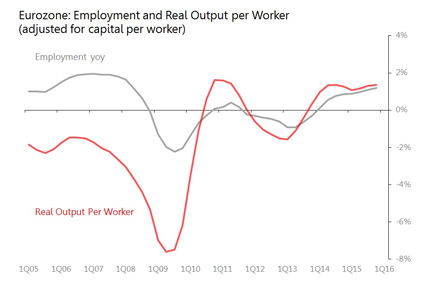 It is sometimes said that the chief skill of a football manager is to pick to which team he should lend his magic at any one time. Much the same might be said of central bankers and their policy initiatives. For example, when Mark Carney accepted the post of Governor of the Bank of England in late 2012, it could be inferred that he was fairly confident the boat was not going down. Something similar may be true of the European Central Bank’s latest clutch of easing measures. The combination of further interest rate cuts (including more deeply negative interest rates on banks’ deposits with the central bank; an enlargement and extension of its asset-buying programme; and a new round of even more generous long-term refinancing offers) probably can’t secure the ECB’s inflation target of near-but-not-quite two percent in the medium term. Nor can they guarantee the rehabilitation of the Eurozone’s banking system: the Japanese experience of the last 25 years shows how hard it is for even the most extreme monetary policy to resuscitate broken banking systems. However, ECB governor Mario Draghi has pushed the new measures at a time when it is reasonable to expect the Eurozone’s current grinding and acyclical expansion to continue and accelerate modestly. If so, future commentators will congratulate M Draghi on the part he played in securing it. The Eurozone is still in the early stages of a weak recovery, with 4Q’s 0.3 percent qoq GDP growth being the 11th successive quarter of sustained fractional growth. This sustained expansion owes nothing to credit growth, but everything to rising employment, which in turn reflects in labour productivity gains wrung out of a labour force in the teeth of a shrinking and aging capital stock. It is not exciting, but it is durable, and it looks very similar to the post-crisis expansions seen already in the UK and US. At the heart of this grinding recovery are improvements in the return on capital, and rising labour productivity. Looking first at return on capital: by 4Q, real GDP was growing at 1.6 percent yoy, and nominal GDP was growing at 2.6 percent yoy, whilst gross fixed capital formation was growing at 3.4 percent yoy in real terms, and 4.1 percent yoy in nominal terms. Eurozone’s nominal capital stock finally stopped shrinking during the middle of 2015, and by the end of the year was growing at about 0.3 percent yoy. With capital stock growing only 0.3 percent whilst nominal GDP is growing around 2.6 percent, the return on capital must be rising. Moreover, unless nominal GDP growth slumps below 0.3 percent yoy, that rise in return on capital will continue for the foreseeable future. How is it being achieved? The answer is: in the same way as we have previously seen in the US and the UK. This recovery is driven by a rise in labour productivity attributable to something other than rises in capital per worker (longer hours? more efficient working? upgraded skills?). As the chart below shows, real output per worker, deflated by changes in capital per worker, has been rising modestly but continuously since 2013, and by the end of last year, output per worker was rising 1.4 percent yoy. This laid the foundations for a similarly modest but sustained rise in employment. By 4Q15, employment was rising 1.2 percent yoy, with 4.5million jobs added since the nadir of 1Q13. |
 That slow and steady rise in employment is also responsible for a slow but steady recovery in demand, achieved in the absence of any noticeable credit cycle, and despite the private sector’s unchanged financial caution. In fact, the private sector is running a savings surplus of just over five percent of GDP, as it has been since 2013. By definition, this savings surplus means the private sector is making more new deposits into the Eurozone banking system than it is taking out in new loans. Nothing the ECB does to interest rates or refinancing opportunities can result rises in net new lending until the private sector waives this financial caution. Even when you flood the banking system with liquidity, as M Draghi is doing, banks’ loan/deposit ratio will fall as the private sector generates net savings flows.So we will wait in vain for the ECB’s policy measures to give the Eurozone’s recovery a credit-fuelled boost. Nevertheless, this weak, grinding and fundamentally acyclical recovery is soundly based, and M Draghi’s reputation will be burnished. For more information: |

